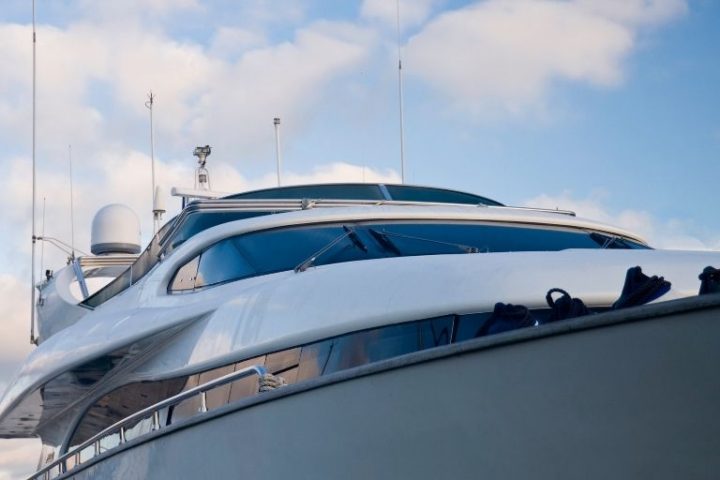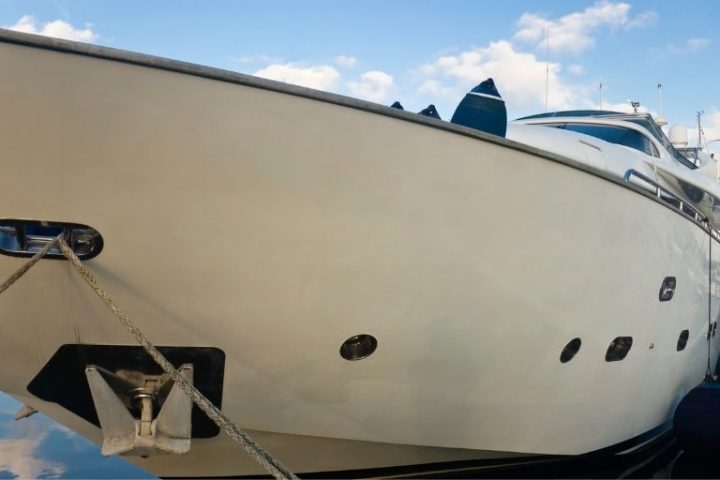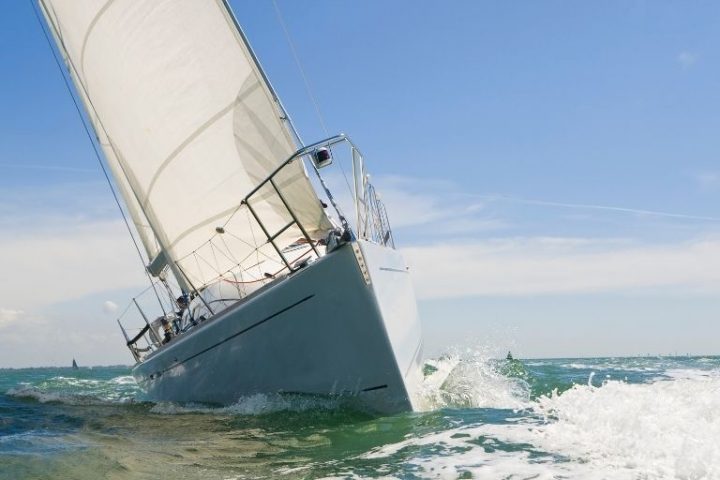Sailboats are not the best choice of transportation when speed is an essential factor. The average speed of the typical monohull sailboat is between six and ten knots. Of course, many factors affect this speed, and some boats are designed to be faster than others. And of course, there are always exceptions to the rule, and some of today’s fastest racing sailboats can fly along at speeds over 50 knots!
Table of Contents
- Measuring Boat Speed – What’s a Knot?
- Types of Boat Hulls
- How do you Calculate Displacement Hull Speed?
- Factors Affecting the Speed of a Sailboat
- Ways to Design a Faster Sailboat
Measuring Boat Speed – What’s a Knot?
Knots and Nautical Miles
The speed of boats and ships is measured in knots or “nautical miles per hour.” This is slightly different than the standard MPH you may use in your car. For example, a nautical mile (nm) equals 6,076 feet, whereas a statute mile is equal to 5,280 feet. So one nautical mile is equivalent to 1.15 statute miles.
Why do boats use nautical miles? The nautical mile is born from the lines of latitude (also called parallels) drawn across the globe by map makers. Each degree of latitude is the same distance from the next one. Each degree contains 60 minutes, and each minute is exactly equal to one nautical mile.
VMG vs. SOG
Finally, it’s also important to realize that there are many ways to measure the velocity of a boat through the water. The simplest method is to use what is commonly called a knot log. In the old days, this was a calibrated string that trailed behind the boat. It was marked by (you guessed it) knots in the string. You let out the string, and the faster the boat was traveling, the more knots passed over the side. So, by counting the knots over a specific time, say ten seconds, you could estimate boat speed through the water.
Today, boats don’t typically carry knot logs. Instead, the modern equivalent is an electrical instrument with a spinning water wheel mounted in the hull. The tiny wheel spins faster as the boat travels faster and it sends the boat’s speed to the instruments.
GPS also provides speed information by telling the captain their SOG (speed over the ground) and VMG (velocity made good). Speed over ground is usually about the same as the boat speed measured by the water wheel – except that SOG is measured across the earth’s surface. So if the boat is being affected by a 2-knot current in the opposite direction, the boat speed may indicate 6 knots while the SOG will show 4 knots.
SOG is the most important speed for calculating trips because it is the actual speed you’re moving to get to Point B. Another way to describe this is VMG (velocity made good). This is the amount of your total speed that is getting you to your next waypoint or destination. If you’re tacking into the wind and not headed directly towards the finish line, your VMG will be significantly less than your SOG.

Types of Boat Hulls
There are three main types of boat hull – displacement, semi-displacement, and planing.
Displacement
Displacement hulled vessels sit down low in the water. This is the classic ship—it just pushes the water out of the way to get where it’s going.
Displacement hulled vessels are limited in the speed at which they can travel. The faster they travel, the larger the bow wave they push up in front of them. The water is pushed up at the bow and then again at the stern. The difference between the bow and the stern waves creates a suction that only increases as power increases. That means that it’s very hard under most circumstances to go any faster.
This concept is known as the hull speed of a vessel—it’s a speed limit that the vessel cannot exceed. The only want to make a boat go faster is to increase the distance between the bow wave and the stern wave—another way of saying that the only want to build a faster boat is to build a longer boat.
Nearly all monohull sailboats have displacement hulls. A displacement hulled vessel may not move very fast, but it is very efficient and takes very little power for its given weight.
Semi-Displacement
If a boat is designed to do it, it can be pushed fast enough to sit up on top of its bow wave. It’s still sitting low in the water, but it can surf that wave just a little and break the stern wave’s suction. This takes an awful lot of power—more than most sailboats can muster—but it is commonly used in large trawlers and powerboats.
Planing
Finally, if a boat has a sleek, flat-bottomed hull and enough power, it can blast over the top of the bow wave and ride on top of the water. This is what go-fast boats and many fishing boats do, along with high-powered dinghies and ski boats.
It takes an enormous amount of power to get a boat on plane, and the amount of power goes up as the vessel’s weight goes up.

How do you Calculate Displacement Hull Speed?
The formula for figuring out the hull speed of a displacement hull in knots is 1.34 times the square root of the vessel’s waterline length in feet – or HS=1.34*√LWL.
If math isn’t your thing, here’s an online calculator. If you crunch some numbers, here are some examples you might come up with.
- 20 feet LWL, 6.9 knots
- 30 feet LWL, 8.4 knots
- 40 feet LWL, 9.8 knots
- 50 feet LWL, 10.9 knots
- 60 feet LWL, 11.9 knots
It is important to remember that the length at the waterline (LWL) is typically less than the length overall (LOA). Therefore, if a vessel has long overhangs, waterline length is reduced.
Factors Affecting the Speed of a Sailboat
For the typical monohull sailboat, the hull speed represents the upper end of its performance. But there are plenty of other factors, and getting up to the speed happens much faster for some vessels than it does for others.
Amount of Wind
If a sailboat is trying to sail, but there is no wind—there’s very little chance of it getting to its hull speed. So one of the most significant factors affecting how quick a sailboat is is how well it sails in “light airs.”
Most cruising sailboats can’t get up to their hull speed until the wind is at a steady 12 to 15 knots. As a general rule of thumb, most of these boats move at roughly half the true wind speed. So a wind of 15 knots moves a boat at about 7.5 knots, and if the wind is only 7 knots, it can typically only make 3.5 knots.
Point of Sail
Even then, they can only do it at certain points of sail. Most boats’ fastest point of sail is when the wind is “on the beam” or coming from the side. This is the most efficient aerodynamically for the sails to work. Sailing dead downwind is one of the least efficient.
Type of Sail Being Flown
Sailing in light winds requires light wind sails. These are typically larger than the boat’s regular cruising sails and made from lighter, more efficient fabric.
Most people are familiar with the spinnaker used for downwind sailing. These large and colorful sails are built out of lightweight material so that a light wind can fill them easily. They can be huge, enough to move a heavy boat in light winds. There are also Code Zeros and gennakers, each of which is a different type of light air sail designed to help boats go faster on calm days.
These sails don’t make the boat go faster, per se. Because they’re built light, you can’t safely fly them with an apparent wind speed over about 15 knots. So what they do is allow a boat to sail when there isn’t enough wind for their regular sails to work.
Amount of Drag
Skin-friction drag comes from the water flowing over the hull. If the bottom of a boat is allowed to become fouled with barnacles and marine growth, it will create more drag. That means that it will be slower than a boat with a perfectly smooth bottom.
There are also other sources of drag to think about. For example, many sailors replace their standard propellers with feathering or folding ones, which produce less drag while sailing.
Sea State
Rough seas are a fast boat’s worst enemy. The action of pounding through lump seas causes the boat’s speed to stop and start, and as a result, it will have difficulty maintaining a fast speed. In these cases, the average speed is used for planning purposes because the speed climbing “uphill” will be slow while the speed surfing down waves will be ridiculously fast.

Ways to Design a Faster Sailboat
We already know that one way to go faster is to buy a longer boat. So how else can the speed of a boat be made faster? Here are three ways.
Modern Hull Designs
Old-school designs typically had larger underwater profiles like full-keel designs. Compared to modern race-inspired boats, which feature spade rudders and deep fin keels, the shape of these boats creates much more drag. The result is that modern designs sail faster in light winds.
Another factor that affects the speed of a boat is the shape of the hull itself, not just the keel. The deeper a hull is, the harder it is to get it to push over the bow wave, even a little bit. As a result, a flat and shallow bottomed sailboat can surf down waves and skip over its bow wave, given enough wind.
It’s this simple design philosophy that has so affected cruising sailboat design over the last few decades. As a result, most cruising boats have become mirrors of racing boats from years past—round, flat bottoms and fin keels.
Multihulls
Most cruising multihulls are displacement hulls like monohull sailboats, yet they can often sail much faster than their hull speeds. Why? They take advantage of a tiny loophole in the rules.
Multihulls use very narrow hulls, which can often cruise at speeds much faster than your standard displacement hull. For example, a catamaran can usually sail 20 or 30 percent faster than a monohull of the same size.
Catamarans and trimarans also go fast by being lightweight. It takes less power to move a lighter object, so they can move much faster in light winds by keeping these boats light. In addition, multihulls do not require lead or iron ballast for stability as monohulls do.
If built for performance, their structures and hulls are commonly made from high-tech materials like carbon fiber. Where monohull cruisers load their boats down with gear and supplies, multihull owners are typically much more careful about the weight they carry on board if they want to maintain their speed advantage.
Foiling Sailboats
The latest trend in the world of sailboat racing is the foil. These boats, both monohulls and multihulls, use underwater wings called hydrofoils to raise the hulls completely out of the water. Once “flying” on the foil, they are no longer bound by standard boating physics.
For example, in the 2020 America’s Cup yacht races, foiling monohulls were used. The AC75 Class race boats are 75 feet long and able to reach speeds of over 50 knots. These new technologies make it possible to sail at up to three times the true wind speed.

